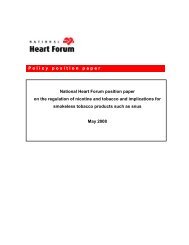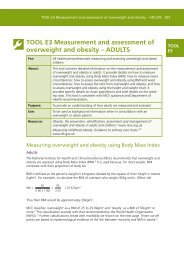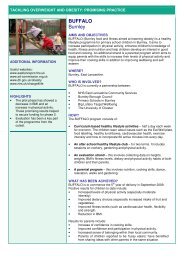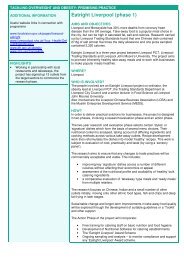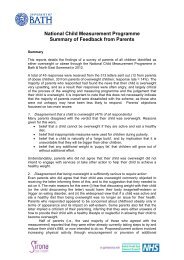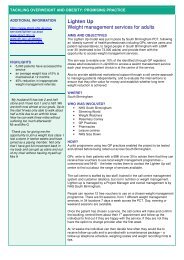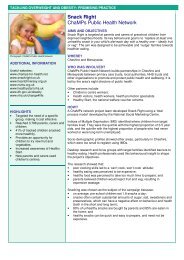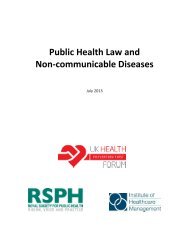The Challenge of Non-Communicable Diseases and Road Traffic ...
The Challenge of Non-Communicable Diseases and Road Traffic ...
The Challenge of Non-Communicable Diseases and Road Traffic ...
Create successful ePaper yourself
Turn your PDF publications into a flip-book with our unique Google optimized e-Paper software.
42 <strong>The</strong> <strong>Challenge</strong> <strong>of</strong> <strong>Non</strong>-communicable <strong>Diseases</strong> <strong>and</strong> <strong>Road</strong> <strong>Traffic</strong> Injuries in Sub-Saharan Africa<br />
BOX 4: <strong>The</strong> Imperative <strong>of</strong> the 2011-2020 UN Decade <strong>of</strong> Action on <strong>Road</strong> Safety in Africa<br />
Unnecessary loss <strong>of</strong> life can be prevented by the adoption <strong>of</strong> measures that are clearly outlined in the five pillars <strong>of</strong> the<br />
ongoing 2011-2020 UN Decade <strong>of</strong> Action for <strong>Road</strong> Safety, which is supported by 103 countries worldwide. <strong>The</strong>se are<br />
geared to:<br />
• Strengthening institutional capacity to further national road safety efforts, including activities such as establishing a<br />
lead agency for road safety in the country involving partners from a range <strong>of</strong> sectors <strong>and</strong> developing a national road<br />
safety strategy;<br />
• Influencing safe road design <strong>and</strong> network management to make roads safer for users, particularly the vulnerable (pedestrians,<br />
cyclists, children, the elderly, bus passengers) <strong>and</strong> reducing the severity <strong>of</strong> crashes;<br />
• Making vehicles safer by adopting motor vehicle safety st<strong>and</strong>ards; implementing new car safety assessment programs;<br />
<strong>and</strong> ensuring that all new cars are equipped with seat belts that meet regulatory requirements <strong>and</strong> pass applicable<br />
crash test st<strong>and</strong>ards;<br />
• Influencing road user behavior through sustained enforcement <strong>of</strong> road traffic laws <strong>and</strong> st<strong>and</strong>ards <strong>and</strong> rules combined<br />
with public awareness/education activities; <strong>and</strong><br />
• Improving post-crash care for the injured, including transporting them in ambulances or rescue helicopters to hospitals<br />
<strong>and</strong> clinics according to a pre-hospital screening process which determines the appropriate health facility to which to<br />
transport patients, rather than sending them to the nearest facility which might not have the capacity to <strong>of</strong>fer needed<br />
care, to prevent further loss <strong>of</strong> life.<br />
adopting isolated interventions. <strong>The</strong> road safety<br />
system (Figure 15) is one scheme for drawing all<br />
these aspects together.<br />
Countries that have successfully reduced RTIs<br />
<strong>and</strong> fatalities – such as, Australia, Great Britain, the<br />
Netherl<strong>and</strong>s, New Zeal<strong>and</strong>, Sweden, <strong>and</strong> the United<br />
FIGURE 15: <strong>The</strong> Safe System Model for <strong>Road</strong> Safety<br />
Admittance to system<br />
(condition for entry/exit <strong>of</strong><br />
vehicles <strong>and</strong> the road user)<br />
Education <strong>and</strong><br />
information supporting<br />
road users<br />
Safer Vehicles<br />
Safer travel<br />
Alert <strong>and</strong> compliant road users<br />
Safer speeds<br />
(lower more forgiving<br />
<strong>of</strong> human error)<br />
Human tolerance<br />
to physical force<br />
Safer travel spaces for<br />
pedestrians <strong>and</strong> cyclists<br />
Source: [268] with an addition by the authors<br />
Safer roads <strong>and</strong> roadsides<br />
(more forgiving<br />
<strong>of</strong> human error)<br />
Underst<strong>and</strong>ing<br />
crashes <strong>and</strong> risk<br />
Enforcement <strong>of</strong><br />
road rules<br />
States – have adopted a safe systems approach which<br />
is anchored in the long-term vision <strong>of</strong> eliminating<br />
road deaths. Under this approach, improved road<br />
safety results depend on three inter-related elements:<br />
institutional management functions, interventions,<br />
<strong>and</strong> results [269].<br />
Some African countries such as Ghana, Kenya,<br />
Namibia, Nigeria, <strong>and</strong> South Africa have in place<br />
most <strong>of</strong> the elements <strong>of</strong> the safe systems approach<br />
but additional efforts are required to strengthen institutions<br />
<strong>and</strong> governance capacity for road safety,<br />
including that <strong>of</strong> the lead agency capacity to better<br />
coordinate <strong>and</strong> manage an effective multisectoral<br />
response.<br />
Sustained support from the highest levels <strong>of</strong> government<br />
is needed to:<br />
• Strengthen the results focus <strong>of</strong> the lead agency <strong>and</strong><br />
coordinate arrangements among sectoral institutions<br />
<strong>and</strong> different levels <strong>of</strong> government;<br />
• Promote active engagement by business, pr<strong>of</strong>essional,<br />
<strong>and</strong> non-government entities;<br />
• Implement policy reviews <strong>and</strong> institutional reforms<br />
to improve legislation <strong>and</strong> enforcement<br />
practices, accountability, <strong>and</strong> the capacity <strong>of</strong> organizations,<br />
<strong>and</strong> the testing <strong>and</strong> licensing <strong>of</strong> drivers<br />
<strong>and</strong> the imposition <strong>of</strong> vehicle safety st<strong>and</strong>ards;



